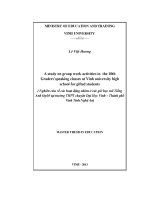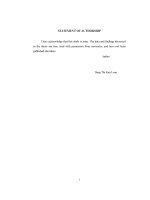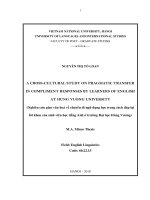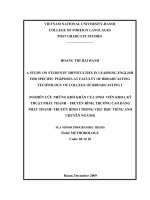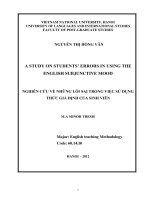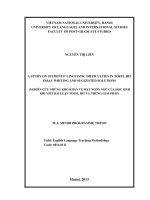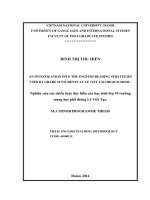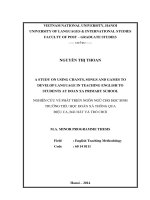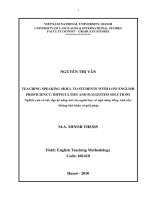A study on students’ linguistic difficulties in TOEFL IBT essay writing and suggested solutions Nghiên cứu những khó khăn về mặt ngôn ngữ của học sinh khi viế
Bạn đang xem bản rút gọn của tài liệu. Xem và tải ngay bản đầy đủ của tài liệu tại đây (1.09 MB, 57 trang )
VIETNAM NATIONAL UNIVERSITY, HANOI
UNIVERSITY OF LANGUAGES AND INTERNATIONAL STUDIES
FACULTY OF POST-GRADUATE STUDIES
NGUYỄN THỊ LIÊN
A STUDY ON STUDENTS’ LINGUISTIC DIFFICULTIES IN TOEFL IBT
ESSAY WRITING AND SUGGESTED SOLUTIONS
(NGHIÊN CỨU NHỮNG KHÓ KHĂN VỀ MẶT NGÔN NGỮ CỦA HỌC SINH
KHI VIẾT BÀI LUẬN TOEFL IBT VÀ NHỮNG GIẢI PHÁP)
M.A. MINOR PROGRAMME THESIS
Field: English Language Teaching Methodology
Code: 6014.0111
Hanoi, 2013
VIETNAM NATIONAL UNIVERSITY, HANOI
UNIVERSITY OF LANGUAGES AND INTERNATIONAL STUDIES
FACULTY OF POST-GRADUATE STUDIES
NGUYỄN THỊ LIÊN
A STUDY ON STUDENTS’ LINGUISTIC DIFFICULTIES IN TOEFL IBT
ESSAY WRITING AND SUGGESTED SOLUTIONS
(NGHIÊN CỨU NHỮNG KHÓ KHĂN VỀ MẶT NGÔN NGỮ CỦA HỌC SINH
KHI VIẾT BÀI LUẬN TOEFL IBT VÀ NHỮNG GIẢI PHÁP)
M.A. MINOR PROGRAMME THESIS
Field: English Language Teaching Methodology
Code: 6014.0111
Supervisor: Prof. Dr. Hoàng Văn Vân
Hanoi, 2013
i
CERTIFICATION OF ORIGINALITY OF THE THESIS
I certify my authorship of the thesis submitted today entitled:
“A study on students’ linguistic difficulties in TOEFL IBT essay writing and
suggested solutions”
in terms of Statement for thesis and Field Study Reports in Master’s Programs
Issued by the Higher Degree Committee.
Nguyễn Thị Liên
October, 2013
ii
ACKNOWLEDGEMENTS
The current research could not have been completed without the
wholehearted support of people who all deserved my deepest gratitude.
Firstly, I want to show my heartfelt gratitude to Professor Hoang Van Van,
my supervisor, for his encouraging this research and giving helpful comments on
earlier drafts of this thesis.
I would also like to thank 88 TOEFL IBT learners at EQuest center for their
enthusiasm for responding to the questionnaires and answering the interview.
Finally, my thank is due to my family, and in particular my two younger
brothers, for their logistical and technical support.
Any remaining flaws concerning this research are merely mine.
iii
ABSTRACT
TOEFL IBT is becoming a prerequisite for students’ studying abroad in
recent years. How to get high scores on TOEFL IBT is a much-discussed topic
among test-takers and educators alike. Among four skills – speaking, listening,
reading, and writing, the last serves as the most challenging skill according to
many students. Composing a TOEFL IBT essay poses many difficulties for both
experienced and inexperienced learners.
The principal aim of this study, basing mainly on survey questionnaire and
interview, is to find out common problems encountered by EQuest learners in
TOEFL IBT Writing and simultaneously to investigate ways to solve these
problems. Data were gathered from 88 TOEFL IBT learners at EQuest center over
a four-week period.
The data obtained from the questionnaire, augmented by interview suggest
that (i) considerable linguistic difficulties faced by EQuest learners in TOEFL IBT
essay writing task 1 involve expression, word choice, spelling, taking notes and
how to relate the ideas from reading passage with those of listening passage; (ii)
linguistic difficulties faced by EQuest learners in TOEFL IBT essay writing task 2
are brainstorming, word choice, academic vocabulary, language formality,
expression, sentence structure, and spelling; (iii) some preferred suggested
solutions to these above problems are providing writing templates, checking ideas
for students before writing, giving in-class feedback, teaching extra vocabulary,
and supply students with further listening and reading exercises to practice note
taking skills (exclusively for TOEFL IBT task 1).
Basing on the findings of the research, some practical suggestions for
TOEFL IBT learners and teachers are put forward. The study, to some extent,
hopefully contributes a small part to the realm of teaching and learning TOEFL
IBT in general and at EQuest in particular.
iv
LIST OF FIGURES
Figure 1. Learners’ background information
Figure 2. Reasons for learners’ taking TOEFL IBT course
Figure 3. Learners’ experience in learning English
Figure 4. Learners’ experience in learning TOEFL IBT
Figure 5. Learners’ opinions of writing skill
Figure 6. Learners’ attitudes towards TOEFL IBT writing skill
Figure 7. Number of essays that learners compose per week
Figure 8. Learners’ linguistic difficulties in TOEFL IBT writing task 1
Figure 9. Correlation between learners’ levels and their possibilities of
encountering difficulties in taking notes, paraphrasing, and relating
points of reading to those of listening
Figure 10. Learners’ linguistic difficulties in TOEFL IBT writing task 2
Figure 11. Correlation between learners’ levels and their possibilities of
encountering difficulties with word choice, expression, and academic
vocabulary
Figure 12. Correlation between frequency in which learners compose essays per
week and their possibilities of encountering difficulties in brainstorming
ideas
Figure 13. Suggested solutions to improve learners’ TOEFL IBT essay writing
v
TABLE OF CONTENTS
Acknowledgements i
Abstract ii
List of figures iii
CHAPTER 1: INTRODUCTION
1. Statement of the problem and rationale for the study 1
2. Aims and research questions 2
3. Significance of the study 2
4. Scope of the study 2
5. Organization 3
CHAPTER 2: LITERATURE REVIEW
1. Academic writing 4
1.1. Definition of writing 4
1.2. Approaches to teaching writing 4
1.3. Writing academic essay 5
2. TOEFL IBT test 5
2.1. Insight into TOEFL IBT test 5
2.2. Insight into TOEFL IBT writing section 7
2.2.1. Format of TOEFL IBT writing section 7
2.2.2. Scoring standards and scoring rubrics of TOEFL IBT writing
section 9
2.2.2.1. Scoring standards 9
2.2.2.2. Scoring rubrics 13
3. Earlier studies on academic writing 14
CHAPTER 3: METHODOLOGY
1. Context of the study 17
2. Selection of the subjects 17
3. Research instruments 18
4. Procedures of data collection 19
vi
5. Procedures of data analysis 20
CHAPTER 4: RESULTS AND DISCUSSION
1. Data analysis and discussion 21
1.1 General information about learners 21
1.2. Students’ linguistic difficulties in TOEFL IBT essay
writing 27
1.3. Suggested solutions for improving students’ TOEFL IBT
essay writing 32
2. Findings 35
2.1. Research question 1 35
2.2. Research question 2 36
3. Implications 37
3.1. For students 37
3.2. For teachers 37
CHAPTER 5: CONCLUSION
1. Summary of findings 39
2. Limitations 39
3. Suggestions for further research 40
REFERENCES 41
APPENDICES I
APPENDIX 1: TOEFL IBT WRITING QUESTION TYPES
APPENDIX 2: PARTICIPANT INFORMATION AND CONSENT
FORM
APPENDIX 3: QUESTIONNAIRES FOR STUDENTS
1
CHAPTER 1. INTRODUCTION
1. Problem statement and rationale for the study
Globalization and economic booming open up a whole new world of
opportunities in education. According to ETS (Educational Testing service, the
world’s largest educational testing and assessment organization), TOEFL IBT
(Test of English as Foreign Language) score can be viewed as a passport to study
abroad. Statistics from ETS in 2013 indicate that more than 9,000 colleges,
agencies and other institutions in over 130 countries accept TOEFL scores. For
this reason, the youth is trying to get as high TOEFL IBT score as possible to get
better impression on their university’s applications, hence, maximize their chances
to be accepted into top international colleges, American ones included.
However, the road to high TOEFL IBT score is not a broad one for every
test-taker. TOEFL IBT is indeed a tough test; unlike other proficiency tests,
TOEFL IBT not only requires learners’ integrated listening-speaking-reading-
writing skills but it also involves learners’ computer skills. TOEFL IBT Writing is
a compelling example of a big challenge brought by the new generation of
TOEFL. As an English instructor majoring in teaching TOEFL IBT at EQuest for
more than three years, I empirically realize that TOEFL IBT learners ranging from
intermediate to advanced ones have to struggle a lot to write a TOEFL IBT writing
essay. Some students think that their main problems lie in time constraint or typing
skills while others blame their troubles for lack of vocabulary or ideas. More
seriously, some others are unaware of their weaknesses and unconsciously
replicate their writing mistakes. What are real problems experienced by EQuest
learners in TOEFL IBT writing? What should be done to improve their writing
skills? Those questions are my overriding concerns when teaching TOEFL IBT
Writing that spark my interest in carrying out the current research on students’
difficulties in TOEFL IBT essay writing and suggested solutions.
2
2. Aims and reasearch questions
The study is conducted with the aim of finding out the linguistic difficulties
that EQuest learners often experience in TOEFL IBT writing essay. Added to this,
some useful suggested solutions to resolve the problems are studied.
The present study is designed to address two following questions:
What are linguistic problems encountered by EQuest learners in TOEFL
IBT writing essay?
What should be done to improve EQuest learners’ TOEFL IBT writing
skill?
3. Significane of the study
The present study is the author’s great endeavor in investigating learners’
major headaches in TOEFL IBT essay writing and ways to eradicate them. This is
hoped to offer both teachers and learners substantial benefits in teaching and
preparing for the TOEFL IBT test. Students will directly benefit from this study in
a sense that they will be aware of major challenges posed by TOEFL IBT writing
essay, hence will know their ways to avoid or beat off them. As for teachers, by
being able to anitipate some awakwardness in their students’ writing, they can
adjust their teaching methods appropriatetly according to students’ competence,
preferences, and expectations to better help ungrade their students’ writing levels.
Moreover, personal boon is also accounted. My main job is teaching
TOEFL IBT for those who want to study overseas. Hopefully, this study would
somehow help me in teaching my students in the right way. This research is also
expectedly a beneficial reference source to teachers working in the same field
feeling the same concern.
4. Scope of the study
Because of constrained time and limited knowledge, this study only deals with
two following issues:
Linguistic problems encountered by EQuest learners in TOEFL IBT writing
essay.
3
Things should be done to improve EQuest learners’ TOEFL IBT Writing
skill.
5. Organization
This chapter is a brief sketch of the study including rationale for the study,
aims and research questions, significance and scope of the study. The precise
details will be given throughout the rest of the study.
Chapter two works on the theoretical background bolstering the issue,
followed by a review of three previous researches on the topic.
Chapter three outlines the relevant research methods for the study as well as
the reasons why these methods are employed. Participant selection, data collection
and data analysis are also included in this chapter.
Chapter four is the discussion and findings of the research in which accurate
statistical analysis and comprehensive explanation are presented with the aim of
giving precise answers to three research questions. Furthermore, pedagogical
implications are given in this section.
Finally, chapter five summarizes the main findings of the research, exposes
some limitations, and puts forward suggestions for further research.
4
CHAPTER 2. LITERATURE REVIEW
1. Academic writing
1.1 Definition of writing
Writing has been defined by a number of scholars. Byrne (1988) notes that
writing is “the act of forming graphic symbols” such as letters or combination of
letters. In this sense, any act of writing producing letters can be viewed as writing.
On the contrary, towards the same issue, Tribble (1996) holds a different opinion
that writing is “not just a graphic representation of speech, but the development
and presentation of thoughts in a structured way”. In other words, writing
involves letter processing and at the same time conveys meaningful messages.
This view is backed up by Lannon (1989) when this author claims that writing is
“a process of transforming the material discovered by research inspiration,
accidents, trial and error, or whatever into a message with a definite meaning”.
On the other hand, Sokolik (2003) views academic writing as “a process
and a product. Writers have to generate ideas, organize, draft, edit, read, reread to
produce a product – a paragraph, an essay, or a report”. It is Soholik’s idea that is
accepted in this study.
1.2. Approaches to teaching writing
There are many ways to approach writing; however, product and process
approaches are the two most popular ones.
The product approach focuses on learners’ final outcome of the writing
process. According to Clenton (2004) and Steele (2002), a typical product
approach has four stages. In stage 1, learners study a model text, analyze it and
imitate its traits. In stage 2, students start their controlled practice of the
highlighted features individually. In stage 3, students work in group to organize
ideas. Then comes stage four in which students are allowed to choose from a wide
range of writing tasks to write about basing on what they have been taught to
produce the final product.
5
On the other hand, the process approach emphasizes students’
communication of ideas, feelings, and experience (Stanley, 2002) with teachers’
intervention as needed (Reid, 1993). The process approach is dissected into eight
principal stages. In stage 1, students come up with ideas by brainstorming and
discussion whereas teachers provide their students with support if necessary. In
stage 2, students check their ideas in term of quality and usefulness. In stage 3,
students organize the ideas in a form of a mind map to make hierarchical
relationship of ideas. In stage 4, students produce the first draft. In stage 5, draft
versions are exchanged for peer check. In stage 6, drafts are returned and students
write the second version basing on suggested improvement. In stage 7, a final draft
is produced and submitted for teachers’ evaluation in stage 8.
1.3. Writing academic essay
An essay is a piece of writing of several paragraphs which tie to the same
topic. An essay has three main parts: an introduction, body (usually two or more
paragraphs), and a conclusion.
The introductory paragraph has two smaller parts: a few general statements
to attract the readers’ attention and a thesis statement to state the main idea of the
essay. The body consists of two or more paragraphs; each deals with one main
idea raised in the thesis statement. The conclusion is summary of all points
discussed in the body.
According to Oshima & Hogue (2006), an essay is judged on five criteria:
Format: title centered, first line of each paragraph indented, margins on
both sides, text double-spaced
Mechanics: periods, commas, semicolons, quotation marks, capitalization,
and spelling
Content: - The essay fulfills the requirements of the assignment.
- The essay is interesting to read.
- The essay shows that the writer used care and thought.
6
Organization: the essay follows the outline, and it has an introduction,
body, and a conclusion.
- Introduction: the introduction ends with a thesis
statement
- Body:
+ Each paragraph of the body discusses a new point
and begins with a clear topic sentence.
+ Each paragraph has a specific supporting material:
facts, examples, quotations, paraphrased or
summarized information, etc.
+ Each paragraph has unity.
+ Each paragraph has coherence.
+ Transitions are used to link paragraphs.
- Conclusion: the conclusion summarizes the main points
or paraphrases the thesis statement, begins with a
conclusion signal, and leaves the reader with the
writer’s final thoughts on the topic.
2. TOEFL IBT test
2.1. Insight into TOEFL IBT test
The Test of English as a Foreign Language (TOEFL) is an examination
operated by the Educational Testing Service (ETS). This is a proficiency test
measuring nonnative learners’ English competence. TOEFL scores are
compulsory for admission into many English speaking colleges, universities,
institutions, and a large number of other agencies in the world, especially United
State.
TOEFL test was coined in 1963 by the National Council on the Testing of
English as a Foreign Language. According to the document “Test and Score
Summary for TOEFL Internet Based Test: September 2005-December 2006 Test
7
Data” published by ETS in 2007, the TOEFL test was co-administered by ETS
and the College Board in 1965. It is now an international trade name of ETS.
The early forms of TOEFL were TOEFL computer-based test (TOEFL
CBT) and TOEFL paper-based one (TOEFL PBT). Since the advent of TOEFL
internet-based test (TOEFL IBT) in 2005 in the United State, Canada, France,
Germany, and Italy in 2005 and the remaining countries in the world one year
later, the TOEFL CBT was discontinued and the TOEFL PBT lost its popularity.
Some researchers bolster a shift from a conventional to an internet-based testing
format because of its reduced testing time, standardized test administration, test
content tailored to examinee ability, automated scoring, and faster score reporting
(Wise & Plake, 1989, cited in Wolfe & Manalo (2005). ETS has now over 4,500
test sites located in more than 165 countries in the world.
Since its introduction, TOEFL IBT has gained its reputation as one of the
most reliable proficiency tests in the English speaking world. According to ETS,
TOEFL IBT is likely to help the test takers stand out because of its fame for
“fairness, quality, and its 100 percent academic content”. TOEFL IBT particularly
assesses how well the candidates integrate their listening, reading, speaking and
writing skills to perform academic tasks, which makes the test a little challenging
but highly appreciated. Stricker & Attali (2010), in their research “Test Takers’
Attitudes About the TOEFL IBT”, claimed that overall attitudes about the TOEFL
IBT were moderately positive in most countries including China, Columbia, and
Egypt. The latest poll of ETS reveals that more than 27 million people from all
over the world have taken the TOEFL test to demonstrate their English-language
proficiency. Needless to say, new generation of TOEFL is the first choice of many
learners longing to study overseas in this modern world.
2.2. Insight into TOEFL IBT writing section
2.2.1. Format of TOEFL IBT writing section
The TOEFL IBT writing is sub-divided into two tasks: integrated task and
independent task.
8
Task
Time
Words
Task 1: Integrated
20 minutes
150-225
Task 2: Independent
30 minutes
300
In the integrated task, the test takers first have three minutes to read and
take notes on a 250─300 word academic passage which usually has three main
points. After reading the passage, the test takers have another two or three minutes
to listen to the listening passage about the same topic either challenging or
supporting the points made in the reading text. The candidates are required to take
detailed notes on the lecture heard. After all, when composing an integrated essay,
the candidates must summarize the main points of the listening passage, then show
how these pointes reinforce or cast doubt on the reading.
Students have 20 minutes to finalize the integrated writing task. The typical
length of one integrated task ranges from 150 words to 225 words.
There are three main question types of TOEFL IBT integrated task:
challenging, supporting, as well as problem and solution. (for more information,
see Appendix 1).
In the independent task, TOEFL IBT candidates are asked to state their
opinions on a particular topic, then use reasons, details, and examples to back up
their points of view. Students have 30 minutes to plan, write, and revise their
essays. Normally, an effective independent essay contains at least 300 words.
There are four sub-types of independent writing question, namely
agreement, preference, details, and assumption. (for more information, see
Appendix 1).
TOEFL IBT is an internet-based test; therefore candidates have to type their
responses to the writing tasks on the computer. The computer only appears some
certain text tools as following:
Copy: copies highlighted text
Cut: cuts highlighted text
9
Paste: pastes copied or cut text
Undo: undoes last action
Redo: redoes action you just undid
Word count: shows number of words written
Enter (twice): starts new paragraph
TOEFL IBT writing undoubtedly tests the learners three skills in one
section, which poses a great challenge to majority of them. Moreover, the learners’
typing skill holds no less importance in TOEFL IBT writing test.
2.2.2. Scoring standards and scoring rubrics of TOEFL IBT writing
section
2.2.2.1. Scoring standards
Integrated writing scoring standards
Score
Task Description
5
A response at this level successfully selects the important information
from the lecture and coherently and accurately presents this
information in relation to the relevant information presented in the
reading. The response is well organized, and occasional language
errors that are present do not result in inaccurate or imprecise
presentation of content or connections.
4
A response at this level is generally good in selecting the important
information from the lecture and in coherently and accurately
presenting this information in relation to the relevant information
presented in the reading, but it may have minor omission, inaccuracy,
vagueness, or imprecision of some content from the lecture or in
connection to points made in the reading. A response is also scored at
this level if it has more frequent or noticeable minor language errors,
as long as such usage and grammatical structures do not result in
anything more than an occasional lapse of clarity or in the connection
10
of ideas
3
A response at this level may contain some important information from
the lecture and conveys some relevant connection to the reading, but it
is marked by one or more of the following:
Although the overall response is definitely oriented to the task,
it conveys only vague, global, unclear, or somewhat imprecise
connection of the points made in the lecture to points made in
the reading.
The response may omit one major key point made in the
lecture.
Some key points made in the lecture or the reading, or
connections between the two, may be incomplete, inaccurate,
or imprecise.
Errors of usage and/ or grammar may be more frequent or may
result in noticeably vague expressions or obscured meanings in
conveying ideas and connections.
2
A response at this level contains some relevant information from the
lecture, but it is marked by significant language difficulties or by
significant omission or inaccuracy of important ideas from the lecture
or in the connections between the lecture and the reading. A response
at this level is marked by one or more of the following:
The response significantly misrepresents or completely omits
the overall connection between the lecture and the reading.
The response significantly omits or significantly misrepresents
important points made in the lecture
The response contains language errors or expressions that
largely obscure connections or meaning at key junctures or that
would likely obscure understanding of key ideas for a reader
11
not already familiar with the reading and the lecture.
1
A response at this level is marked by one or more of the following:
The response provides little or no meaningful or relevant
coherent content from the lecture.
The language level of the response is so low that it is difficult
to derive meaning.
0
A response at this level merely copies sentences from the reading,
rejects the topic or is otherwise not connected to the topic, is written in
a foreign language, consists of keystroke characters, or is blank.
ETS, retrieved 2004, from
Independent writing scoring standards
Score
Task description
5
An essay at this level largely accomplishes all of the following:
Effectively addresses the topic and task
Is well organized and well developed, using clearly appropriate
explanations, exemplification, and/ or details
Displays unity, progression, and coherence
Displays consistent facility in the use of language,
demonstrating syntactic variety, appropriate word choice, and
idiomaticity, though it may have minor lexical or grammatical
errors
4
An essay at this level largely accomplishes all of the following:
Address the topic and task well, though some points may not be
fully elaborated
Is generally well organized and well developed, using
appropriate and sufficient explanations, exemplifications, and/
12
or details
Displays unity, progression, and coherence, though it may
contain occasional redundancy, digression, or unclear
connections.
Displays facility in the use of language, demonstrating
syntactic variety and range of vocabulary, though it will
probably have occasional noticeable minor errors in structure,
word forms, or use of idiomatic language that do not interfere
with meaning
3
An essay at this level is marked by one or more of the following:
Addresses the topic and task using somewhat developed
explanations, exemplifications, and/ or details
Displays unity, progression, and coherence, though connection
of ideas may be occasionally obscured
May demonstrate inconsistent facility in sentence formation
and word choice that may result in lack of clarity and
occasionally obscure meaning
May display accurate but limited range of syntactic structures
and vocabulary
2
An essay at this level may reveal one or more of the following
weaknesses:
Limited development in response to the topic and task
Inadequate organization or connection of ideas
Inappropriate or insufficient exemplifications, explanations, or
details to support or illustrate generalizations in response to the
task
A noticeably inappropriate choice of words and word forms
An accumulation of errors in sentence structure and/ or usage
13
1
An essay at this level is seriously flawed by one or more of the
following weaknesses:
Serious disorganization or underdevelopment
Little or no detail, or irrelevant specifics, or questionable
responsiveness to the task
Serious and frequent errors in sentence structure or usage
0
An essay at this level merely copies words from the topic, rejects the
topic or is otherwise not connected to the topic, is written in a foreign
language, consists of keystroke characters, or is bank.
ETS, retrieved 2004, from
2.2.2.2 Scoring rubrics
The total score for the writing section of TOEFL IBT is 30 (out of 120).
Each writing task is worth maximum of five points. The average of points earned
from two tasks is finally converted into a scale score of 0-30.
Converting rubric scores to scales scores
Writing rubric mean
Scaled score
5.00
30
4.75
29
4.50
28
4.25
27
4.00
25
3.75
24
3.50
22
3.25
21
3.00
20
14
2.75
18
2.50
17
2.25
15
2.00
14
1.75
12
1.50
11
1.25
10
1.00
8
7
5
4
0
3. Earlier studies on academic writing
Writing skill is an interesting topic which has been studied by a number of
researchers. In accomplishing this research, I have read some previous researches
dealing with the topic. Of relevance to the present research are three studies.
The first (Lan, B.P, 2007) investigated importance of paragraph writing to
students at National Economics University (NEU), their difficulties in paragraph
writing, causes of these common errors, and effective strategies for teaching
writing paragraphs. The results of the study indicated that all students partaking in
the study have positive attitudes towards their paragraph writing course. Lan, B.P
(2007, p.35) revealed that even though the NEU students have studied English for
a long time, more than 10 years, their writing skills are very poor. They often
commit many mistakes in writing concerning organization, content, and most
seriously use of language. Another important finding of the study was students’
preference for teaching writing methodology. Most of them prefer the teacher’s
provision of language knowledge, explanations of sample paragraphs, and group
15
discussion to self-studying through reading materials. However, the research failed
to explicitly explain causes of students’ committing errors in paragraph writing.
The second (Hoa, N.T, 2008) sought to find out students and teachers’
difficulties in learning and teaching writing the textbook “Writing 1” at Hung
Vuong university and ways to sort out those problems. The findings suggested that
students’ typical difficulties in learning writing with the textbook “Writing 1” are
lack of vocabulary, lack of cultural knowledge, first language interference, and
poor grammar. Teachers who were directly teaching writing using that textbook
also face numerous troubles such as the textbook itself, repetition of teaching
techniques in every class, ways to correct students’ errors, shortage of writing
reference materials, and lack of teaching aids. Accordingly, some suggested
solutions are put forward: organizing writing workshop, distributing diagnostic
test to students, equipping students with some knowledge of contrast between
English and Vietnamese, employing diverse error correction techniques.
The third (Asaoka & Usui, 2003), a longitudinal study, investigated kinds
of problems encountered by students while they completed their writing
assignments as well as the ways they handle the problems in an English for
Academic Purposes (EAP) program at a Japanese university. The kinds of
problems the participants had trouble with while completing an essay assignment
could be roughly divided into three areas: surface-level problems (grammar,
expressions, mechanics), macro-level problems (planning, topic, coherence,
organization), and external factors (deadline, word count requirements, availability
of appropriate sources, students’ perceptions of teachers’ expectations, lack of
positive reinforcement, and their attitudes toward the first language use). Ways to
help the students better at writing mainly include teachers’ provision of more
grammatical exercises in class, teachers’ intervention and construction at an early
stage of students’ writing when they choose the topics, teachers’ supportive and
open attitudes towards students’ ideas, plans, and concerns through individual
meetings, and teachers’ flexibility in writing schedule.
16
In short, academic writing has been the topic of many writers. The matters
discussed in these above researches are relevant to my teaching area and leave
important lessons to be learnt. However, these available studies focus on matters
in academic writing in general; no studies come across with any investigation
involving difficulties experienced by learners in TOEFL IBT writing, which
leaves a research gap for the author of the present study to implement.
17
CHAPTER 3. METHODOLOGY
1. Context of the study
The present study is conducted at EQuest, an English center with ten-year
experience in providing educational services such as GRE, GMAT, SAT, TOEFL,
IELTS, and TOEIC. Among various courses at EQuest, the new generation
TOEFL, (TOEFL IBT) preparation courses often attract high school students in
Hanoi who yearn to study abroad. In order to take part in the TOEFL IBT courses,
students have to take a placement test. If they get 60-74 points out of 120 points,
they will be entitled to enroll TOEFL A course. If they earn more than 74 points
out of 120 points, they will get a chance to study in TOEFL B classes.
Each TOEFL IBT course lasts about 3 months, 3 sessions a week, and 2
hours a lesson. Studying materials are in-house ones compiled by EQuest
instructors and edited regularly to fit the learning situation. During each course,
students are required to take regular progress tests in order to mark their skill
improvement.
The primary goal of TOEFL IBT courses is to help learners to earn high
scores in the actual test. Helping students sharpen their English skills in an
academic environment and get familiar with American oriented learning styles in
universities in the United State serves as another goal of TOEFL IBT preparation
courses.
2. Participants
The participants of the study are my 88 TOEFL IBT students from 6 classes
at EQuest (43 TOEFL A students and 45 TOEFL B students). Their levels of
English are intermediate and upper-inter mediate (they gained 75-90 TOEFL IBT
scores in the placement test). Their target scores when completing the courses
range from 90 to more than 100 scores (out of the maximum of 120 scores) to
apply for scholarships funded by American colleges and universities.
The majority of selected subjects come from high schools in Hanoi; they
often have one year or two more years to obtain TOEFL IBT score to finalize their

